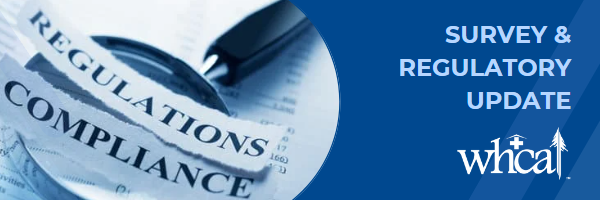August 22 2025 | Elopement
A missing resident can be a scary and dangerous situation. Many long-term care facilities have developed and implemented systems to minimize the likelihood of resident elopement; the best facilities perform unannounced elopement drills to test the system’s strength and address areas for improvement.
It is important to be aware that there can be a difference between a resident elopement and a missing resident. While elopement is not defined in rule, it is generally understood as an unknown departure that is not acknowledged or recognized through customary procedures, such as “signing out” or part of the resident’s individualized plan of care including known patterns of activity. A resident elopement may be when they leave the facility or community property completely or it may be entering an unsecured area or designated resident safe area.
A missing resident refers to a situation where a resident cannot be located within the facility or on its premises and there is a concern for their safety and wellbeing. It is unknown after a quick search of the general living area and premises where the resident is at. The resident does not have to leave the facility or grounds to be determined missing.
It is vital to look at the circumstances of each event and implement an immediate response protocol as well as a preventative approach to ensure resident safety.
According to the 2024 CNA Aging Services Professional Liability Claims Report, assisted livings continue having a higher portion of elopement claims than skilled nursing facilities, however payouts remain high in both sectors. Closed claims for elopement averaged just over $344,000 for assisted livings and just shy of $167,000 for skilled nursing facilities.
Perhaps one reason that contributed to higher elopement claims in assisted living is the fact that memory care units by and large are licensed as assisted living facilities. Assisted livings have an expectation and requirement for a “homelike environment,” which has historically resulted in minimal use of alarms and other notification methods; these factors could heighten exposure to elopements and subsequent lawsuits.
Many elopements involve allegations of improper resident monitoring; these events can result in serious injuries such as death, hypothermia, heat stroke, head injuries or fractures.
According to the CNA report, 45.5 percent of elopements result in resident death; higher claims (with an average of $417,000) were paid in death cases, whereas other outcomes such as fractures resulted in lesser payouts.
The CNA report captured the most frequent issues of facility related to elopements, including failure to:
- Assess/evaluate the resident’s risk of elopement upon admission/move-in, at least quarterly thereafter, and with any change in condition
- Maintain sufficient staff to monitor residents’ whereabouts
- Employ alarms or other devices to monitor residents who wander and prevent elopements
- Ensure staff respond appropriately to alarms and missing resident situations
The CNA report includes recommendations for facility leadership and staff to minimize elopements. Those risk management recommendations include:
ASSESSMENT/EVALUATION
Perform consistent elopement risk assessments/evaluations upon admission/move-in, quarterly, with change in condition, and after an elopement or attempted elopement. Review risks during daily meetings and address wandering/exit-seeking trends in quality assurance/improvement meetings.
CARE/SERVICE PLANNING
Address and document elopement risk in each resident’s care/service plan. Include resident-specific interventions, and train staff to implement those interventions.
DOCUMENTATION
Observe and document residents’ wandering behaviors; analyze the data to determine underlying cause(s) and motivation(s). Address and document when interventions are not effective and new interventions are put into place. Ensure readily-available resident identification information in the event of an elopement. Conduct regularly-scheduled, purposeful rounding to know residents’ whereabouts, and maintain rounding records.
MONITORING SYSTEMS
Ensure all equipment is in working order, including door locks, facility alarms, personal resident alarms, key codes/fobs, cameras, and other devices. The facility should have routine inspections and testing protocols, with records supporting these activities as well as preventive maintenance. Implement keypad integrity that includes routine changing of codes and updating codes whenever a breach occurs. Key fobs should not be distributed to unauthorized users such as family members. Monitor weather and implement safety protocols when outside areas are accessible to residents, visitors, and staff. Notify and engage local law enforcement in missing resident protocols as soon as a resident is noted as missing.
COMMUNICATION
Communicate with health care providers and families when there is an exit-seeking incident or change in condition. Monitor exit-seeking behavior to identify triggers and communicate those to the team. Create a work environment where team huddles are the norm, so residents’ changes can be addressed quickly.
ROOT CAUSE ANALYSIS
Use a systematic approach to address an elopement incident investigation (to include near misses), including identification of contributing factors. Document and monitor contributing factors and interventions to reduce the risk of recurrence.
TRAINING AND EDUCATION
Train staff, visitors, and family members on how to minimize resident “tailgating” activity. Train staff on the facility’s missing resident policy and procedure, including their specific roles in searching for a missing resident; this should occur upon hire and at least annually, with documentation in each staff person’s file. Periodically conduct facility-wide elopement drills and analyze the results; address concerns and retrain as necessary.
WHCA will continue with this series on liability claims and payouts; next month’s article will focus on resident falls. For more information on this series please email Elena Madrid (for skilled nursing providers) or Vicki McNealley (for assisted living providers).

